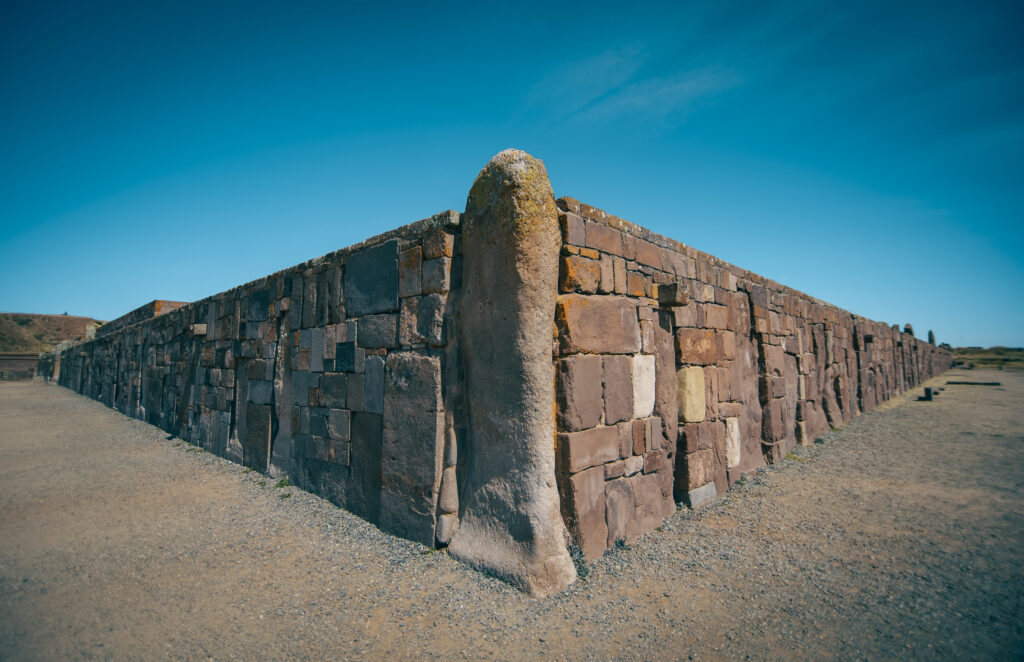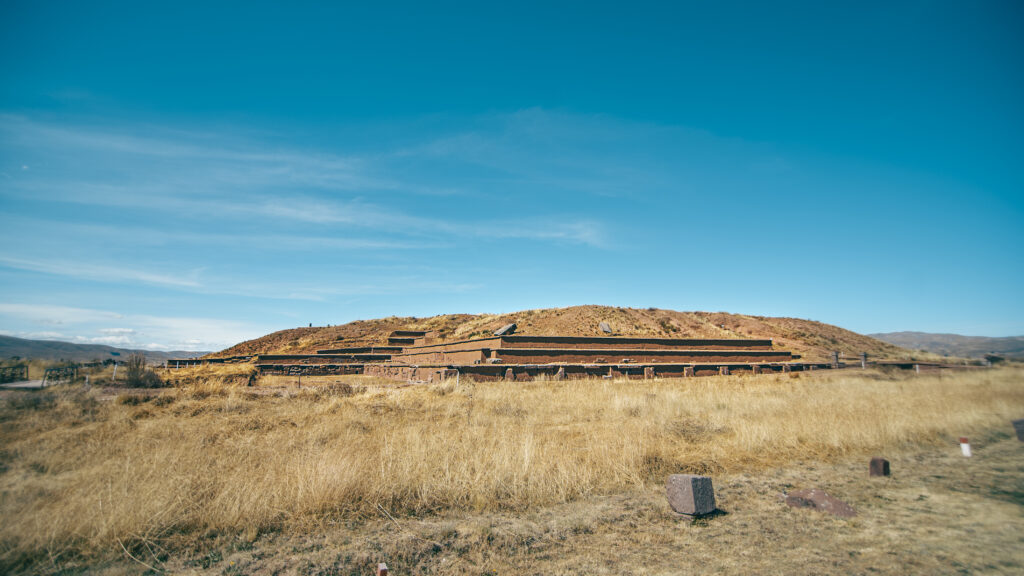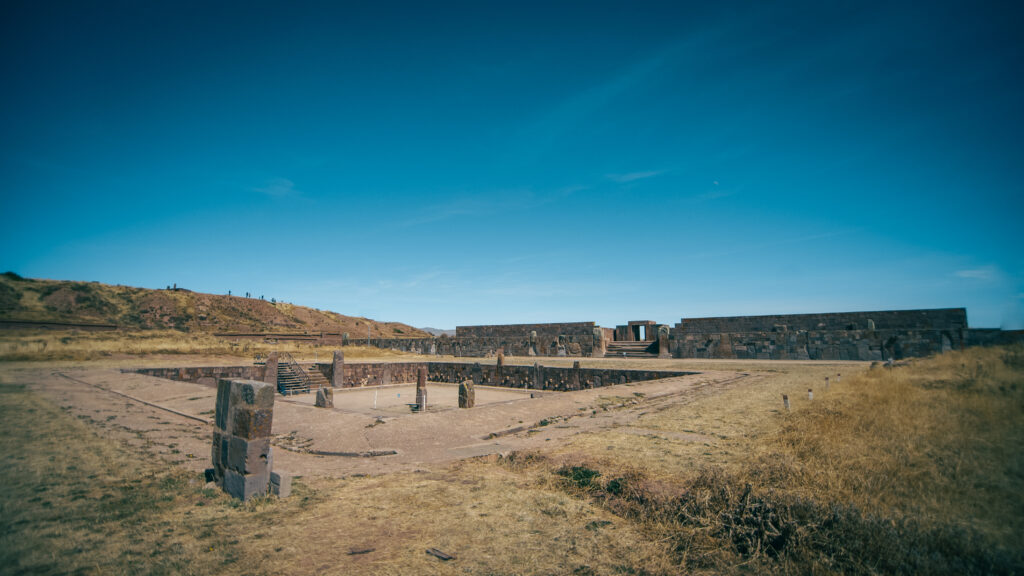
Según la leyenda aymara Tiwanaku apareció cuando el Inca Dose Capaca, el «sariri-caminante vigilante» estando en la ciudad, vio venir a un emisario corriendo. El Inca fue a su encuentro y le dijo en aymara «Tiai, wanaku» que signifuca «Siéntate, guanaco».
Una cultura preincaica que se expandió en Bolivia, Perú y norte de Chile entre los años 1500 a. C. y 1187 d. C. Su capital y principal centro religioso es Tiwanaku al sur del lago Titicaca. Se encuentra a 72 km desde la ciudad de la paz, aproximadamente a 2 horas de viaje, en la provincia Ingavi a una altura de 3870 msnm.
Se caracteriza por su arquitectura Se extiende por una superficie de 600 hectáreas aproximadamente, con varios elementos en relieve por ejemplo en la Puerta del Sol (se cree que las tallas poseen un significado astronómico y / o astrológico y pueden haber tenido un propósito calendárico), destacan siete construcciones arquitectónicas importantes: El Kalasasaya, el templete semisubterráneo, la pirámide de Akapana, la Puerta del Sol, El Puma Punku y templete , también grandes pirámides y esculturas como el Monolito Ponce, Monolito Benett y Monolito Fraile entre otros.
El «Museo Regional de Tiahuanaco» exhibe parte de una importante colección obtenida del mismo sitio, apreciándose hermosas piezas de cerámica, líticas, metálicas, artefactos fabricados en hueso, restos humanos, etc. que fueron rescatados a través de diferentes excavaciones científicas en el área.
Según Alan L. Kolata, arqueólogo estadounidense que realizó sucesivas excavaciones en este sitio durante los años ochenta y principios de los noventa, alrededor del año 1000, la ciudad tenía una población de 115 000 habitantes, junto con otros 250 000 en los campos circundantes. Para muchos, estas cifras son muy elevadas; se dice que es más probable que la ciudad haya alcanzado en su apogeo una población de veinte o treinta mil personas.
Inscrito por la UNESCO como «Tiwanaku: centro espiritual y político de la cultura Tiwanaku» en la lista de Patrimonio Cultural de la Humanidad, «por el excepcional valor arqueológico y cultural que poseen las ruinas líticas de la ciudad de Tiwanaku, desde donde un grupo humano contribuyó decisivamente en la investigación y desarrollo de tecnologías de construcción, agricultura, crianza de ganado, tejido de fibras vegetales y animales», el 2 de diciembre de 2000.
According to Aymara legend, Tiwanaku appeared when the Inca Dose Capaca, the «sariri-walker vigilant» while in the city, saw an emissary coming running. The Inca went to meet him and said in Aymara «Tiai, wanaku» which means «Sit down, guanaco».
A pre-Inca culture that spread in Bolivia, Peru and northern Chile between the years 1500 a. C. and 1187 AD C. Its capital and main religious center is Tiwanaku at the south of Titicaca Lake. It is located approximately 2 hours away (72 km) from La Paz city, , in the Ingavi province at an altitude of 3,870 meters above sea level.
It is characterized by its architecture It extends over an area of approximately 600 hectares, with several elements in relief, for example in La Puerta del Sol (the carvings are believed to have an astronomical and/or astrological significance and may have had a calendrical purpose), Seven important architectural constructions stand out: The Kalasasaya, the semi-subterranean temple, the Akapana pyramid, La Puerta del Sol, El Puma Punku temple, also great pyramids and sculptures such as the Ponce Monolith, Benett Monolith and Fraile Monolith among others.
The «Museo Regional de Tiahuanaco» exhibits part of an important collection obtained from the same site, appreciating beautiful pieces of ceramics, lithics, metal, artifacts made of bone, human remains, etc. that were rescued through different scientific excavations in the area.
According to Alan L. Kolata, an American archaeologist who conducted successive excavations at this site during the 1980s and early 1990s, around the year 1000, the city had a population of 115,000, along with another 250,000 in the surrounding countryside. For many, these figures are very high; it is said that it is more likely that the city at its highest point reached a population of twenty or thirty thousand people.
Registered by UNESCO as «Tiwanaku: spiritual and political center of the Tiwanaku culture» on the list of Cultural Heritage of Humanity, «due to the exceptional archaeological and cultural value of the stone ruins of the city of Tiwanaku, from where a human group contributed decisively to the research and development of construction technologies, agriculture, cattle raising, weaving of vegetable and animal fibers», on December 2, 2000.








